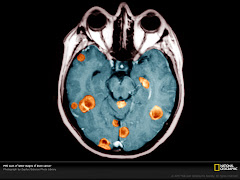First, symptoms of a brain tumor could include everything from severe headaches to seizure to stroke. Particularly, loss of feeling in an arm or leg, double vision, hearing loss, dizziness, nausea and aphasia. Different parts of the brain can be affected based on its location. MRI's and CT scans are performed to obtain accurate information on size and location of possible tumors.
There are four grades of common brain tumors as in other cancers:
Grade I: Pilocytic Astrocytoma
Grade II: Low-grade Astrocytoma
Grade III: Anaplastic Astrocytoma
Grade IV: Glioblastoma (GBM)




Stage 1 Stage 2 Stage 3 Stage 4 respectively
Grade I tumors have slowed growth, accounts for approximately 2% of all brain tumors and occurs most often in children and young adults.
Grade II tumors are also slow growing and while they have a low risk of metastasizing to other areas of the body, they do have undefined borders and are found equally in men and women.
Grade III tumors grow faster than grades I and II and likely invade other tissue areas. They are more common in males and account for 4% of all brain tumors.
Grade IV tumors are the most invasive of all brain tumors and commonly spread to other parts of the body. They have very aggressive growth rates and are composed of various cell types. Grade IV tumors are more common in men in their 50's-70's and account for 23% of all brain tumors. The likelihood of Grade IV tumors recurring is very high and about 5% of patients survive 2 years.
Nearly all brain tumors are treated with surgery followed by radiation, chemotherapy or both concurrently.
Just over 43,000 primary brain tumors are diagnosed every year in the United States and even with surgery and treatment, prognosis of high grade gliomas is slim. While there are advocacy programs across the country for brain tumors, we are taking our own role in actively searching for treatments that could ultimately lead to a cure.
Follow our progress on our grid computing project at this link: folding@home
(If the link for this doesn't work then right click and copy the link location and then paste it into the search bar)
To find out more about grid computing projects go to this link: volunteer@home
National Brain Tumor Society

Excellent start! Your format is ideal - the project description will remain visible throughout the semester even as you add new posts. You have included very complete descriptions of the disease and the grid, and your links are active (and it looks fantastic!). Well done. 5/5
ReplyDelete